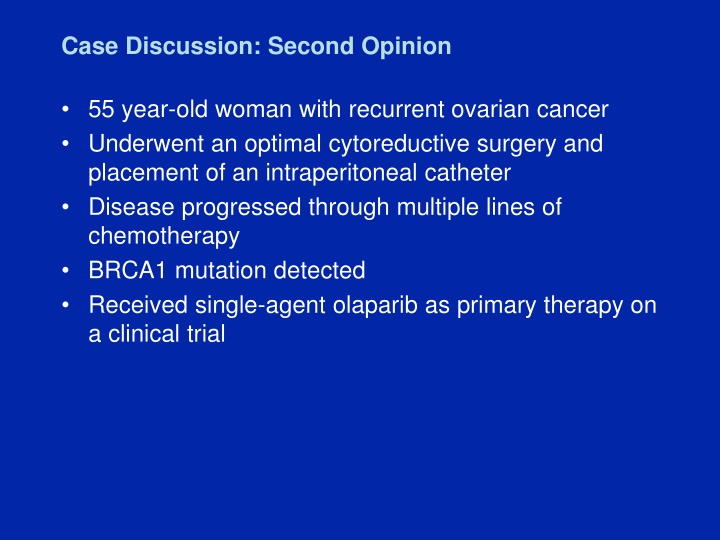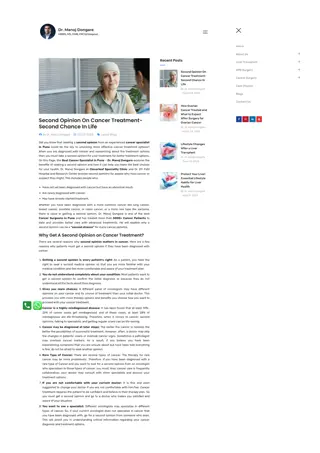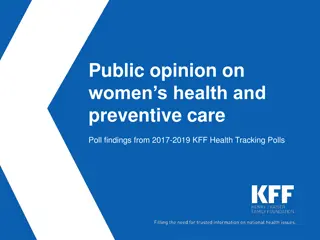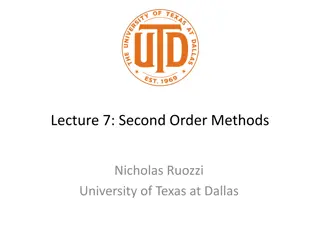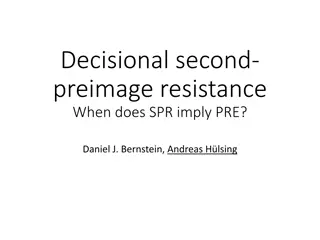Case Discussion: Second Opinion
In this case discussion, a 55-year-old woman with recurrent ovarian cancer and a BRCA1 mutation received olaparib as primary therapy. The importance of BRCA testing for high-risk patients and the common side effects of PARP inhibitors are highlighted. Studies on DNA repair, PARP inhibition, and clinical trials with niraparib and olaparib are discussed.
Download Presentation

Please find below an Image/Link to download the presentation.
The content on the website is provided AS IS for your information and personal use only. It may not be sold, licensed, or shared on other websites without obtaining consent from the author.If you encounter any issues during the download, it is possible that the publisher has removed the file from their server.
You are allowed to download the files provided on this website for personal or commercial use, subject to the condition that they are used lawfully. All files are the property of their respective owners.
The content on the website is provided AS IS for your information and personal use only. It may not be sold, licensed, or shared on other websites without obtaining consent from the author.
E N D
Presentation Transcript
Case Discussion: Second Opinion 55 year-old woman with recurrent ovarian cancer Underwent an optimal cytoreductive surgery and placement of an intraperitoneal catheter Disease progressed through multiple lines of chemotherapy BRCA1 mutation detected Received single-agent olaparib as primary therapy on a clinical trial
PARP Inhibitors: Common Side Effects One of the class effects has been gastrointestinal toxicities some nausea, dyspepsia, anorexia, occasional vomiting, and some lower GI effects, which is diarrhea. But it s mostly upper GI effects. Ursula A Matulonis, MD
Importance of BRCA Testing for Patients with Ovarian Cancer This is the one way that we can help prevent ovarian cancer. We don t have screening mechanisms at all, but we do have a way of identifying high-risk women, and it s exactly here. You ve got a patient who s got the unfortunate diagnosis. Well, let s make some good from this and disseminate that information to the rest of the family, that they should undergo testing. Ursula A Matulonis, MD
DNA Repair and PARP Inhibition Dysfunctional BRCA Functional BRCA McLornan DP et al. N Engl J Med 2014;371(18):1725-35.
ENGOT-OV16/NOVA: A Phase III Trial of Niraparib Maintenance in Platinum- Sensitive, Recurrent Ovarian Cancer Niraparib 300 mg QD until PD Germline BRCA mutation (n = 203) R Accrual (n = 553) Platinum- sensitive, recurrent OC 2 platinum- based regimens 2:1 Placebo 2:1 Niraparib 300 mg QD until PD No germline BRCA mutation* (n = 350) R Placebo *Patient tumors were tested for homologous recombination deficiency (HRD) Primary endpoint:PFS Mirza MR et al. N Engl J Med 2016;375(22):2154-64.
Study 19: A Phase II Trial of Olaparib Maintenance in Platinum-Sensitive Relapsed Ovarian Cancer Olaparib (n = 136) Placebo (n = 129) Hazard ratio (HR) p-value All patients Median PFS 8.4 mo 4.8 mo 0.35 <0.001 Median OS 29.8 mo 27.8 mo 0.73 0.025 BRCA1 mutation positive n = 48 n = 45 HR p-value Median OS 33.4 mo 26.6 mo 0.60 NR BRCA2 mutation positive n = 26 n = 17 HR p-value Median OS 57.2 mo 40.7 mo 0.62 NR NR = Not reported Ledermann J et al. N Engl J Med 2012;366(15):1382-92 Ledermann JA et al. Lancet Oncol 2016;17(11):1579-89.
Press Release October 26, 2016 Positive results from the Phase III SOLO-2 trial to determine the efficacy of Olaparib (300 mg BID) as monotherapy for the maintenance treatment of platinum-sensitive relapsed, BRCA-mutated ovarian cancer Results from the trial demonstrate a clinically-meaningful and statistically-significant improvement of progression-free survival (PFS) among patients treated with olaparib compared to placebo and provide additional evidence to support the potential use of olaparib in this patient population. Importantly, the median PFS in the olaparib arm of SOLO-2 substantially exceeded that observed in the Phase II maintenance study in patients with platinum- sensitive relapsed ovarian cancer (Study 19). https://www.astrazeneca.com/media-centre/press-releases/2016/lynparza-phase-iii-solo-2-trial- shows-significant-progression-free-survival-benefit-261020161.html
ENGOT-OV16/NOVA Trial: Median PFS p-value Niraparib Placebo HR Germline BRCA mutation (n = 138, 65) 21.0 mo 5.5 mo 0.27 <0.001 No germline BRCA mutation with HRD positivity (n = 106, 56) 12.9 mo 3.8 mo 0.38 <0.001 No germline BRCA mutation (n = 234, 116) 9.3 mo 3.9 mo 0.45 <0.001 Mirza MR et al. N Engl J Med 2016;375(22):2154-64.
Case Discussion: Second Opinion 45 year-old woman with Stage IIIA serous ovarian cancer Germline BRCA2 mutation-positive Optimal debulking carboplatin/paclitaxel x 6 cycles Patient currently has no evidence of disease, normal CA-125 levels Would you prescribe niraparib maintenance for this patient?
SOLO-1: A Phase III Trial of Olaparib Monotherapy for BRCA-Mutated Ovarian Cancer Accrual (n = 397) Newly diagnosed, high-risk ovarian cancer Prior platinum-based chemotherapy Presence of deleterious or suspected deleterious BRCA1/2 mutation Olaparib (300 mg BID) R Placebo (300 mg BID) Primary endpoint: PFS Clinicaltrials.gov; NCT01844986
PAOLA-1: An Ongoing Phase III Trial of Olaparib with Bevacizumab as Maintenance Therapy for Advanced Ovarian Cancer Accrual (n = 612) Olaparib + bevacizumab Newly diagnosed, high-grade ovarian, fallopian tube or peritoneal cancer FIGO Stage IIIB-IV Completed first-line platinum/taxane therapy 3 cycles of bevacizumab with last 3 cycles of platinum-based chemotherapy Presence of BRCA1/2 mutation R Placebo + bevacizumab Primary endpoint: PFS Clinicaltrials.gov; NCT02477644
Select Ongoing Trials of Immune Checkpoint Inhibitor Therapy for Patients with Ovarian Cancer Trial name Phase N Treatment arms Population NCT02657889 (TOPACIO) Pembrolizumab + Niraparib Recurrent ovarian or TNBC I/II 114 Pembrolizumab + paclitaxel + carboplatin Newly diagnosed ovarian NCT02520154 II 30 Pembrolizumab + bevacizumab + cyclophosphamide Recurrent ovarian, fallopian tube or primary peritoneal NCT02853318 II 40 Relapsed epithelial ovarian, fallopian tube or peritoneal Nivolumab + bevacizumab NCT02873962 II 38 Clinicaltrials.gov (accessed January 2017)
Case Discussion: Second Opinion 62-year-old woman with recurrent ovarian cancer Germline BRCA mutation-positive Initiating third-line therapy with olaparib 400 mg PO BID After 4 weeks on olaparib, hemoglobin drops from 10.5 g/dL to 8.5 g/dL No evidence of bleeding or hemolysis Should this patient receive an erythropoiesis stimulating agent?
Case Discussion: Second Opinion 54-year-old woman with germline BRCA2 mutation- positive disease receives olaparib Patient does well on olaparib for 10 months, at which point slow, asymptomatic growth of peritoneal metastatic nodules is noted Should this patient continue on olaparib with the addition of a new agent (eg, chemotherapy or bevacizumab)?
Side Effects Associated with PARP Inhibitors As a class effect, PARP inhibitors have two main toxicities. One is gastrointestinal, and then secondly bone marrow suppression. So, I think you have to expect both when you start any of these PARP inhibitors in patients... I think the GI toxicity is pretty much the same. And I ve been impressed how some patients are just more sensitive to the GI toxicity. I guess what we don t have yet and that decision-making is not there yet if you ve got three, or even two PARP inhibitors in play, and you start off with one and you say, Wow! You re having a lot of nausea from this drug. Let s see if we switch you to another one, what will happen. Ursula A Matulonis, MD
PARP Inhibitors: Management of Treatment- Associated Nausea in Patients If a patient starts to develop some nausea or vomiting, or anorexia or dyspepsia more often than not those side effects will get better. Exactly why that occurs, not sure, but those side effects tend to get better. In a less ideal world, you d give that patient a break. For PARP inhibitors, these drugs are meant to be given continuously Unless the patient is having a lot of distress, I think taking away the PARP inhibitor, may not be the best thing to do. Ursula A Matulonis, MD
PARP Inhibitors: Comparison of Dosage and Administration Olaparib Rucaparib Niraparib Available dosage form* 50 mg capsule 300 mg tablet 100 mg tablet 400 mg twice daily, oral (800 mg total) 600 mg twice daily, oral (1,200 mg total) Dosing and administration 300 mg once daily, oral Total number of capsules/tablets per day 16 4 3 *The SOLO-1 and SOLO-2 trials evaluated a 300 mg twice daily dosing of olaparib in a higher dosage tablet form. This formulation is not currently FDA approved. Olaparib package insert; Rucaparib package insert; www.clinicaltrials.gov
Case Discussion: Second Opinion 54-year-old woman with high-grade serous ovarian cancer Achieved a CR with carboplatin/paclitaxel (IV) x 6 cycles CA-125 spiked after 11 months and received 2 lines of therapy afterwards
Case Discussion: Second Opinion 54-year-old woman with high-grade serous ovarian cancer Achieved a CR with carboplatin/paclitaxel (IV) x 6 cycles CA-125 spiked after 11 months and received 2 lines of therapy afterwards Tested for BRCA status at this point and disease was found to be BRCA mutation-positive She is currently receiving olaparib (3 months) When would you observe evidence of an objective response?
Recommendations for BRCA1 and BRCA2 Testing Despite that agreement and despite guidelines that have come from SGO, ASCO and others, we still have a number of people with as many as 20 to 40 percent, depending on which paper you read, not getting tested in patients who have epithelial ovarian cancer, which is very unfortunate. Thomas J Herzog, MD
Mechanism of Cell Death from Synthetic Lethality Induced by PARP Inhibition Iglehart JD. N Engl J Med 2009;361(2):189-91.
ENGOT-OV16/NOVA Trial of Niraparib Maintenance Therapy: Median PFS Results Hazard ratio p-value Niraparib Placebo Germline BRCA mutation (n = 138, 65) 21.0 mo 5.5 mo 0.27 <0.001 HRD positive with somatic BRCA mutations (n = 35, 12) 20.9 mo 11.0 mo 0.27 0.02 HRD positive with wild-type BRCA (n = 71, 44) 9.3 mo 3.7 mo 0.38 <0.001 No germline BRCA mutation, HRD negative (n = 92, 42) 6.9 mo 3.8 mo 0.58 0.02 No germline BRCA mutation (n = 234, 116) 9.3 mo 3.9 mo 0.45 <0.001 Mirza MR et al. N Engl J Med 2016;375(22):2154-64.
Phase II OV21/PETROC Trial vs Phase III GOG 252 Trial for Patients with Stage II-IV Disease OV21/PETROC1 (Stage IIB-IV) IV chemo (n = 101) IP chemo (n = 102) HR (p-value) Median PFS 11.3 mo 12.5 mo 0.82 (0.27) Median OS 38.1 mo 59.3 mo 0.80 (0.40) IV carbo + bev IP carbo + bev IP cisplatin + bev GOG 2522 Median PFS (Stage II-III) 26.8 mo 28.7 mo* 27.8 mo* Median PFS (Stage III, no visible residual disease) 31.3 mo 31.8 mo* 33.8 mo* *No significant difference versus IV carboplatin 1 Mackay H et al. Proc ASCO 2016;Abstract LBA5503; 2 Walker JL et al. Proc SGO 2016;Abstract LBA6.
ENGOT-OV16/NOVA Biomarker Populations 553 patients enrolled 203 350 gBRCAmut Primary efficacy non-gBRCAmut Primary efficacy 162 134 54 HRD-positive Primary efficacy HRD-negative Primary efficacy HRD not determined Primary efficacy 47 115 BRCA wildtype Exploratory 26 14 14 Somatic BRCAmut Exploratory Inconclusive result Inadequate specimen Missing specimen gBRCAmut = germline BRCA mutation; HRD = homologous recombination deficiency Mirza MR et al. N Engl J Med 2016;375(22):2154-64.
Clinical Implications of the ENGOT-OV16/NOVA Trial Results Which patients benefit the most from niraparib maintenance therapy? Based on prolongation of PFS: Patients with germline BRCA mutations benefit (HR = 0.27; p < 0.001) Patients with HRD-positive somatic BRCA mutations benefit (HR = 0.27; p = 0.02), and their response is similar to that of patients with germline BRCA mutations Even patients without germline BRCA mutation and with HRD-negative disease benefit (HR = 0.58; p = 0.02). Michael Birrer, MD, PhD
Comparison of PARP Inhibitors Olaparib, niraparib and rucaparib Niraparib is associated with higher thrombocytopenia Rucaparib is associated with higher anemia Toxicities are manageable Veliparib Binds more weakly to target than olaparib, niraparib and rucaparib Potentially easier to combine with chemotherapy Talazoparib Has a higher binding capacity than other PARP inhibitors Michael Birrer, MD, PhD
